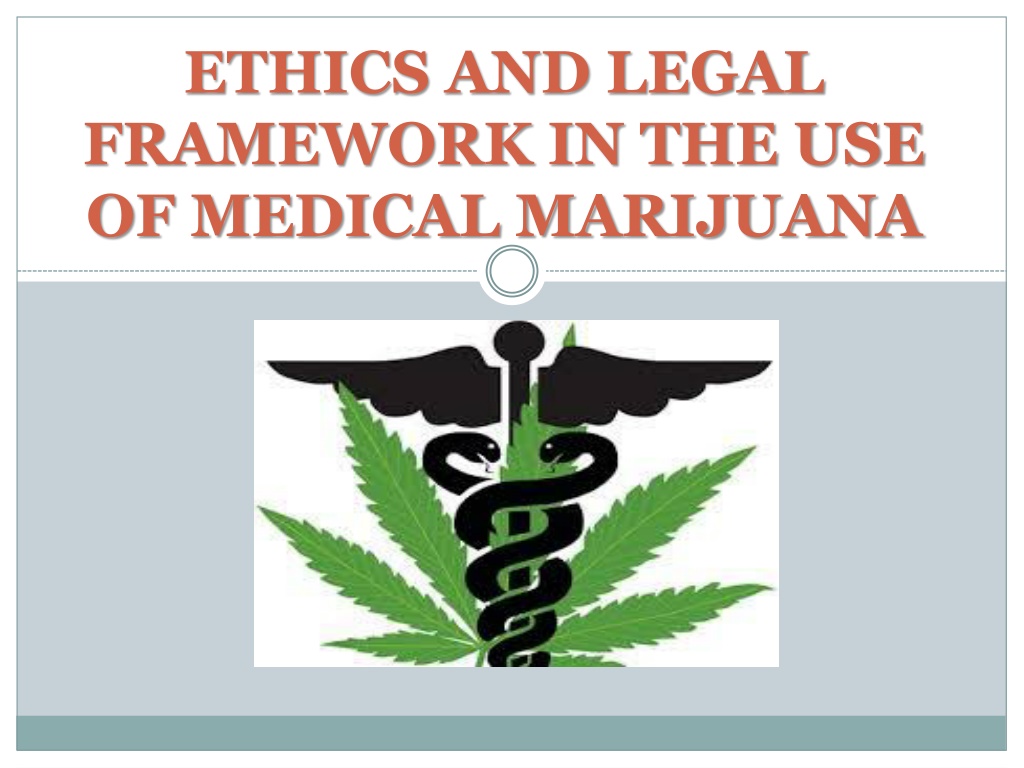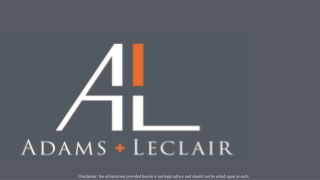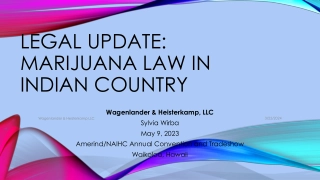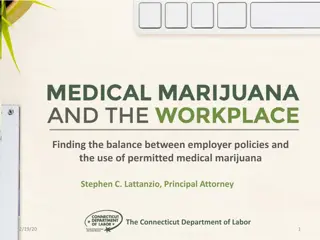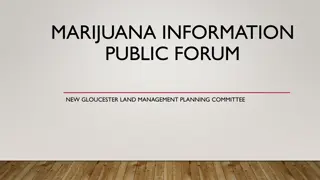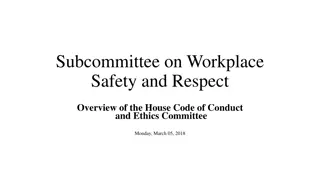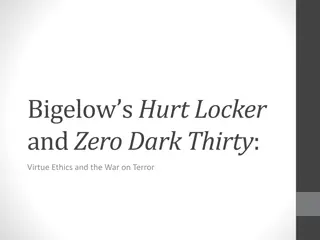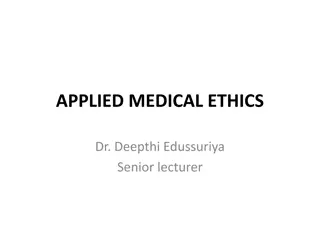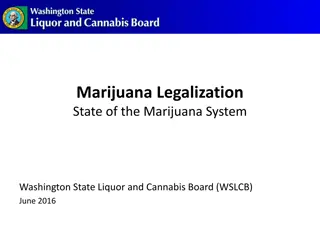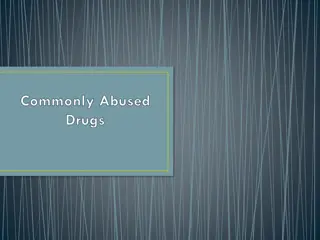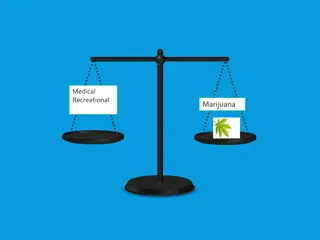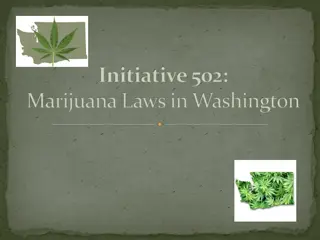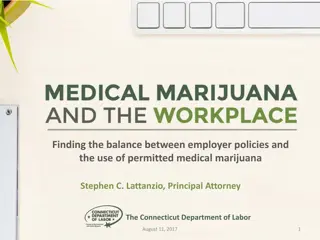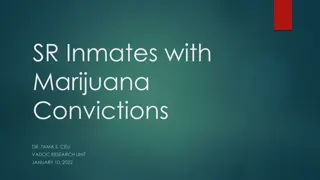Ethics and Legal Framework in Medical Marijuana Use
Cannabis use for medical purposes raises ethical dilemmas and legal considerations. This article covers the background, ethical implications, medical uses, associated risks, and legal frameworks in the US and EU. It examines the components of cannabis, ethical issues such as patient autonomy, potential benefits like pain relief and antiemetic effects, and risks including dependence, social impacts, and effects on various body systems.
Download Presentation

Please find below an Image/Link to download the presentation.
The content on the website is provided AS IS for your information and personal use only. It may not be sold, licensed, or shared on other websites without obtaining consent from the author. Download presentation by click this link. If you encounter any issues during the download, it is possible that the publisher has removed the file from their server.
E N D
Presentation Transcript
ETHICS AND LEGAL FRAMEWORK IN THE USE OF MEDICAL MARIJUANA
INTRODUCTION Cannabis is the illicit drug which is used the most worldwide. Widespread debate: Should cannabis be legalized? Difference between medical and recreational use
INDEX Background and origins Ethical implications Medical uses Risks associated Legal framework in US Legal framework in EU
BACKGROUND Cannabis sativa is an angiosperm that is able to grow in many different climates an ecosystems. Original from Asia but spread all over the world nowadays
BACKGROUND More than 400 components identified: 60 % belong to the group cannabinoids: - THC and cannabidiol as more representatives
BACKGROUND How they affect organism? - Interaction with multifunctional membrane receptors CB1 and CB2. - CB1: brain, spinal cord and sensitive areas - CB2: peripheral tissues. Immunity and inflammation procedures
ETHICAL ISSUES Main question Does potential benefits of medical marijuana exceed potential risks? Other ethical implications How does this affect to Patient-Doctor relationship? How much autonomy should patient have in its administration?
POTENTIAL BENEFITS Used in treatment for: -Chronic pain associated with cancer - Neuropathic pain - Potentiate opioid activity: analgesic -Inhibition of muscle spasticity: Multiple sclerosis. -Glioblastoma therapy -Glaucoma -Reduce nausea and vomiting associated with chemotherapy
POTENTIAL RISKS - Tolerance and dependance - Affect to social relationships - Nervous system: exacerbate pre-exisiting psychotic disorders - Respiratory system: Inflammation of airways. Chronic bronchitis - CVS system: vasodilation, tachycardia, mild hypertension - Fetal development: Malformations, lower weight at birth - Teratogenic and mutagenic effects: associated to some types of cancer - Marijuana as a link to more dangerous drugs.
DOCTOR - PATIENT RELATIONSHIP Doctor is sometimes acting illegally if they recommend the use of a drug that it is NOT fully approved by FDA or other Drug administrations Some doctors may refuse to prescribe it even if it is legal in their country or state Existence of specialized marijuana-prescribing doctors
AUTONOMY - Difficult to perform clinical trials to determine exact doses for marijuana treatment - Possibility of abusing of its use by patient - Not every patient is the same: age, sex, mental conditions and many other factors play a role
LEGAL FRAMEWORK Although cannabis remains a prohibited substance worldwide, nowadays there are some exceptions according to its medicinal and therapeutical use (regulatory regimes) However, not all regulatory regimes are equal worldwide, a consensus hasn t been reached yet. Here there are some examples:
LATIN AMERICA Especially Latin american and the Caribbean countries are following this trend, enacting policies that enable patients to access certain types of preparations to alleviate symptoms, reduce pain or improve their quality of life (policies allowing access to cannabis for therapeutic use). For example, Uruguay is the first country in the world to completely legalise the cannabis market for medical and scientific purposes, as well as for industrial and recreational use.
USA A total of 33 states, the District of Columbia, Guam and Puerto Rico have approved a comprehensive public medical marijuana/cannabis programs. California (1996) 13 states allowed the usage of "low THC, high cannabidiol (CBD)" products for medical reasons in limited situations or as a legal defense. Only in 4 states no public marijuana access program (Kansas, Nebraska, South Dakota and Idaho)
COMPREHENSIVE PROGRAMS (33 STATES) Protection from criminal penalties. Access to marijuana through home cultivation, dispensaries or some other system. It allows a variety of strains, including those more than "low THC . It allows either smoking or vaporization.
SPECIAL CONDITIONS ACCORDING TO STATE (US) -For example, in states like New York, West Virginia and Puerto Rico, it may not or cannot be smoked. - In the case of Vermont (adult-use legalization legislation) adults 21 years or older are allowed to possess up to one ounce of marijuana and to grow two mature plants. Public consumption and selling of marijuana remains illegal.
SPECIAL CONDITIONS ACCORDING TO STATE (US) -Majority of the states do not recognize patients from other states, and if they do, they often cannot purchase through dispensaries. - In those states who have LIMITED ACCESS MARIJUANA PRODUCT LAWS (LOW THC), the legality of the usage or prescription depends on the medical condition that the patient suffers from, mostly related to intractable epilepsy, seizure disorders, cancer or ALS.
FEDERAL ISSUES (US) However, at a federal level marijuana is still considered to have a high potential for dependency and no accepted medical use, making distribution of marijuana a federal offense (medical marijuana "prescriptions" are more often called "recommendations" or "referrals ) States with medical marijuana laws generally have some form of patient registry, which may provide some protection against arrest for possession up to a certain amount of marijuana for personal medicinal use.
EU -Netherlands: Best example of well-established medicinal cannabis model (Medicinal canabbis agency) in pharmacies for a number of pathologies in possession of a medical prescription. Cannabis cultivation is legal. -Germany: medicinal cannabis must be covered by both private insurers and public health services. Seriously ill patients can buy cannabis by prescription. The permission is granted for a maximum of three days. -Czech Republic: medical cannabis is legalized since 2013, but it is not usually covered by the health insurance system. Only may be authorized under special conditions e.g. Oncology treatments -United Kingdom: the government only permits the use of Sativex for patients with multiple sclerosis, under medical prescription, and every patient must pay for his or her medication (about 500 euros a month).
EU Some other examples: -Poland: medicinal cannabis could be sold in registered pharmacies. Patients need a special permission from a regional pharmaceutical inspector and a physician accredited by the Ministry of Health. No domestic production or self-cultivation. -Greece: patients can access medicinal cannabis products, in recognition of their benefits for specific illnesses (chronic pain, glaucoma and multiple sclerosis for example). It also proposes that individuals can cultivate cannabis for medicinal use. The bill has not come into force yet.
EU In other countries, medicinal cannabis is limited to pilot projects: -Denmark, Ireland: cannabis for therapeutic purposes is still illegal, but a pilot programme will begin this year (in the case of Denmark) for a limited number of patients with specific health problems (i.e. multiple sclerosis, chronic pain, back injury, nausea and effects of chemotherapy). -Some other countries in which medical use of cannabis is legal: Austria, Finland, France, Italy, Norway, Portugal, Spain and Sweden
REFERENCES http://www.ncsl.org/research/health/state-medical- marijuana-laws.aspx http://www.medicalmarijuana.eu/ The American Society of Addiction Medicine. The role of the physician in "medical" marijuana. 2010. http://fileserver.idpc.net/library/Medicinal%20cann abis%20briefing_ENG_FINAL.PDF
